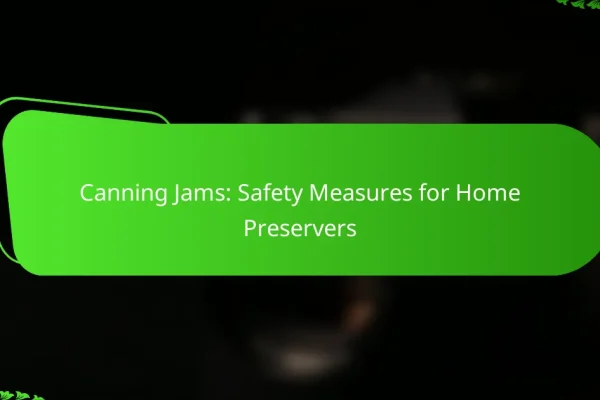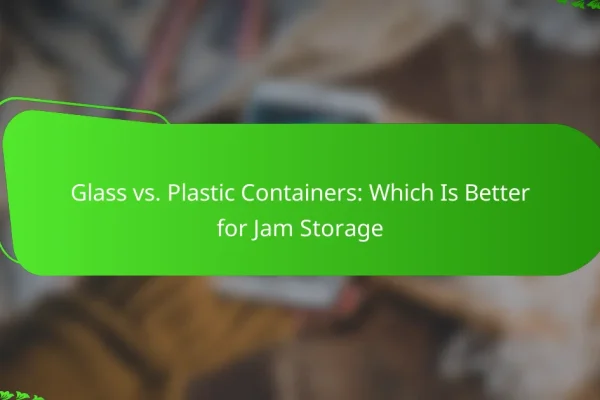How to store jams for optimal freshness?
To maintain the optimal freshness of jams, proper storage techniques are essential. This includes using airtight containers, refrigerating after opening, utilizing vacuum sealing, and storing in a cool, dark place.
Use airtight containers
Airtight containers are crucial for preserving the flavor and texture of jams. They prevent air exposure, which can lead to spoilage and loss of quality. Glass jars with tight-fitting lids or plastic containers designed for food storage work well.
When transferring jam to a new container, ensure it is clean and completely dry to avoid introducing moisture. Label containers with the date of opening to keep track of freshness.
Refrigerate after opening
Once opened, jams should be refrigerated to slow down bacterial growth and preserve their taste. Keeping jams in the fridge can extend their shelf life significantly, often up to several weeks.
Make sure to seal the container tightly after each use to minimize air exposure. If you notice any signs of mold or off-smells, discard the jam immediately.
Utilize vacuum sealing
Vacuum sealing is an effective method for extending the shelf life of jams. By removing air from the packaging, this technique reduces oxidation and helps maintain flavor and color.
Investing in a vacuum sealer can be beneficial, especially if you make large batches of jam. Vacuum-sealed jars can last for several months in the refrigerator or even longer in the freezer.
Store in a cool, dark place
Storing jams in a cool, dark place helps prevent degradation from light and heat. A pantry or cupboard away from direct sunlight is ideal for unopened jars.
Temperature fluctuations can affect the quality of jams, so aim for a consistent environment. Avoid storing jams near the stove or in areas with high humidity, as these conditions can lead to spoilage.
What are the best preservation methods for homemade jams?
The best preservation methods for homemade jams include canning, freezing, and using sugar as a preservative. Each method has its own advantages and considerations, making it essential to choose one that fits your needs and preferences.
Canning with water bath method
Canning with the water bath method is a popular technique for preserving homemade jams. This method involves sealing jars of jam and submerging them in boiling water for a specified time to kill bacteria and create a vacuum seal.
To successfully can your jams, ensure you use proper canning jars and lids, and follow a reliable recipe that specifies processing times. Commonly, jams should be processed for 5-15 minutes, depending on the recipe and jar size.
Be cautious of overfilling jars, as this can prevent proper sealing. Always check seals after cooling; if a lid pops back when pressed, the jar is not sealed and should be refrigerated and used promptly.
Freezing in freezer-safe jars
Freezing is an easy and effective way to preserve homemade jams, especially if you plan to use them within a year. Use freezer-safe jars or containers, leaving some headspace to allow for expansion as the jam freezes.
When freezing, it’s important to cool the jam completely before transferring it to jars. Label each jar with the date and type of jam to keep track of your inventory. Generally, jams can maintain quality for about 6-12 months in the freezer.
To thaw, simply move the jar to the refrigerator for several hours or overnight. Avoid refreezing thawed jam, as this can affect texture and flavor.
Using sugar as a preservative
Using sugar as a preservative is a traditional method that helps extend the shelf life of homemade jams. Sugar not only adds sweetness but also inhibits the growth of microorganisms by drawing moisture out of the fruit.
For effective preservation, aim for a sugar-to-fruit ratio of about 1:1, though some recipes may vary. High sugar content can also enhance flavor and improve the jam’s consistency.
Keep in mind that while sugar acts as a preservative, jams should still be stored in a cool, dark place and consumed within a reasonable time frame, typically within a year for optimal taste and quality.
How long can you store jams?
Jams can be stored for varying lengths of time depending on whether they are unopened or opened. Proper storage conditions are essential to maintain their quality and safety.
Unopened jams last up to 1 year
Unopened jars of jam can last for up to one year when stored in a cool, dark place, such as a pantry. The key is to ensure that the jars remain sealed and free from contamination.
Check the expiration date on the label for guidance, but if stored correctly, many jams can remain safe and tasty beyond this date. Always inspect for signs of spoilage before use.
Opened jams last 6 months in the fridge
Once opened, jams should be refrigerated and can typically last for about six months. Keeping them in the fridge slows down spoilage and preserves flavor.
To maximize freshness, use clean utensils each time you scoop out jam to avoid introducing bacteria. If you notice any off smells, discoloration, or mold, it’s best to discard the jam.
What are the signs of spoiled jam?
Signs of spoiled jam include off smells or tastes and visible mold growth on the surface. Recognizing these indicators is crucial to ensure food safety and maintain quality.
Off smell or taste
An off smell or taste is a primary indicator that jam has spoiled. Fresh jam should have a sweet, fruity aroma and flavor, while spoiled jam may emit sour or rancid odors, indicating fermentation or bacterial growth.
If you notice any unusual flavors, it’s best to discard the jam. Consuming spoiled jam can lead to foodborne illnesses, so trust your senses when assessing quality.
Mold growth on the surface
Mold growth on the surface of jam is a clear sign of spoilage. Even if the mold appears to be only on the top layer, it can penetrate deeper into the product, making it unsafe to eat.
When you see mold, do not attempt to scrape it off; instead, dispose of the entire jar. Proper storage in a cool, dark place can help prevent mold formation and extend the shelf life of your jam.
What are the best jars for jam storage?
The best jars for jam storage are glass mason jars and plastic freezer containers. Each option has unique benefits, making them suitable for different storage needs and environments.
Glass mason jars
Glass mason jars are a popular choice for storing jams due to their airtight seals and durability. They come in various sizes, typically ranging from 250 ml to 1 liter, allowing for flexibility based on the quantity of jam.
When using glass jars, ensure they are properly sterilized before filling them with jam to prevent spoilage. A common practice is to boil the jars for about 10 minutes or run them through a dishwasher cycle on high heat.
Store filled mason jars in a cool, dark place, such as a pantry or cupboard. If you plan to keep the jam for an extended period, consider refrigerating or freezing the jars after opening.
Plastic freezer containers
Plastic freezer containers are ideal for long-term storage of jam, especially if you plan to freeze it. These containers are lightweight and come in various sizes, making them convenient for portioning out jam.
When using plastic containers, ensure they are freezer-safe to avoid cracking or warping. Leave some space at the top of the container to allow for expansion as the jam freezes.
Label the containers with the date and type of jam for easy identification later. Remember that while plastic containers are great for freezing, they may not provide the same shelf life as glass jars when stored at room temperature.
How to label and date stored jams?
Labeling and dating stored jams is essential for tracking freshness and ensuring safe consumption. Proper labeling helps you identify contents and manage your pantry effectively.
Use waterproof labels
Waterproof labels are crucial for preserving the information on your jam jars. They withstand moisture and condensation, which can occur during storage. Choose labels made from durable materials that can resist fading and smudging over time.
Consider using a label maker or purchasing pre-printed waterproof labels to ensure clarity. This prevents any confusion about the contents, especially if the jars are stored in humid environments.
Include date and contents
Always include both the date of preparation and the type of jam on your labels. This practice allows you to monitor how long the jam has been stored and helps you prioritize older jars for use. A simple format like “Strawberry Jam – 10/2023” works well.
When labeling, use a permanent marker or a printed label to ensure the information remains legible. Regularly check your stored jams and consume them within a year for the best quality and flavor.
What are the benefits of preserving jams at home?
Preserving jams at home offers several advantages, including better control over ingredients and the ability to customize flavors. Home preservation can also be more cost-effective compared to store-bought options, allowing for a more personal touch in your culinary creations.
Control over ingredients
When you make jams at home, you have complete control over the ingredients used. This means you can select high-quality fruits, adjust the sweetness to your preference, and avoid artificial preservatives or additives commonly found in commercial products.
Consider using organic fruits or local produce to enhance flavor and support local farmers. You can also experiment with natural sweeteners like honey or maple syrup, which can provide unique tastes and health benefits compared to refined sugars.
Be mindful of food safety standards when selecting ingredients. Always wash fruits thoroughly and use clean equipment to prevent contamination during the jam-making process.












